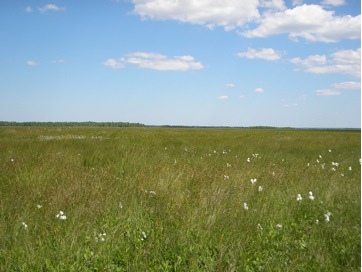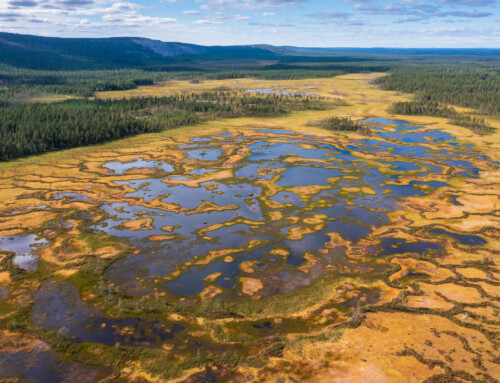Do we know enough to save it?
LINKED PAPER
Optimal habitat conditions for the globally threatened Aquatic Warbler Acrocephalus paludicola in eastern Poland and their implications for fen management.
Janusz Kloskowski, Franziska Tanneberger, Piotr Marczakiewicz, Anna Wiśniewska &
Agata Choynowska. 2015. IBIS. DOI: 10.1111/ibi.12247
Listen to a singing Aquatic Warbler whilst you read this blog
Why must we protect the Aquatic Warbler?
Aquatic Warbler is Europe’s rarest migratory songbird and the only globally threatened passerine found in mainland Europe. In the past, it occurred from France to Siberia and from Italy to Latvia, but currently its range is much more restricted – almost exclusively to Poland, Belarus and Ukraine. During the 20th century the size of its population decreased by 95%, mainly as a result of destruction of its unique habitat. Currently, the population of Aquatic Warbler numbers only c. 12,000 singing males, and the breeding area actually occupied by this species covers no more than 375 km2. Owing to such a limited area of occurrence, Aquatic Warblers have been included on the IUCN Red List of Globally Threatened Species as Vulnerable (category VU). Poland has an enormous responsibility to conserve the Aquatic Warbler, because c. 25% of the world’s population is found within the country.
The Aquatic Warbler – an umbrella species
The Aquatic Warbler is a so-called umbrella species, representative for its specific habitat (fen mires), and all the other animal and plant species that make up the ecological community of this habitat. Many of these species, like Aquatic Warblers, cannot survive anywhere apart from in such wetlands. This means, that protecting Aquatic Warblers means protecting much more than just one species of bird. Aquatic Warbler protection helps many rare plant species and other species of birds, including rare waders.
Why are Aquatic Warblers declining?
The main threat that the Aquatic Warbler face is the loss of their habitat. Fen mires have been drained on a large scale during the last century, most often for conversion to agriculture. Habitats deteriorate due to drainage, too frequent or too early mowing, or too intense grazing. During early mowing or intensive grazing in the breeding period, the birds are scared away and their nests are destroyed. Only a small proportion of central European fen mires have escaped such a fate, although even those areas have been negatively affected by drainage in their surroundings. Despite of this, favourable conditions for the species were to a certain degree sustained in those areas, thanks to traditional, low-intensity farming, based on hand-mowing and cattle grazing. As long as these agricultural practices continued, Aquatic Warblers could inhabit even slightly drained sites. However, cessation of extensive land use, which took place during the last decades, led to overgrowing of marshes with dense reeds or bushes and trees, which in turn results in a continuous loss of Aquatic Warbler habitat. Modern mowing practices in fen mires that are not (or are slightly) drained differ substantially from traditional hand mowing due to the use of heavy tracked vehicles, and their effects on habitat conditions are not yet fully understood. An additional problem is habitat destruction in areas where the birds stopover during migration, and on their wintering grounds in Western Europe and in Africa.
What has been done about it?
In 2003, a Memorandum of Understanding Concerning Conservation Measures for Aquatic Warblers was concluded under the auspices of the Bonn Convention on the Conservation of Migratory Species of Wild Animals (CMS). The signatory countries to the Memorandum are obliged to work together to improve the conservation status of the Aquatic Warbler. A major recent conservation achievement was the LIFE Aquatic Warbler project in Poland and Germany in 2005-2011. To date, this is the biggest single species conservation project implemented in Poland. The main beneficiary, responsible for coordinating the project and implementing a significant part of the project activities in Poland, was the Polish Society for the Protection of Birds (OTOP). In the course of the project, a targeted study was carried out to identify the exact parameters of an “ideal habitat” for the species, which could then be applied to the project sites. The knowledge fed into site management plans and the official Aquatic Warbler Species Action Plans for Poland.

Ławki Mire, Biebrza National Park, Poland. June 2008. A high-quality habitat of the Aquatic Warbler.
© Anna Wiśniewska
Outcomes on optimal habitats in Eastern Poland
To identify optimal habitat, we related numbers of singing males to habitat variables in all core breeding sites in eastern Poland. Aquatic Warbler densities were the highest in areas with extensive ground cover by water and mosses and a thick litter layer. Optimal vegetation height was 60 – 90 cm. Male densities increased with increased biomass of arthropods larger than 10 mm in length, as estimated by sweep netting, and with increased abundance of spiders, as estimated by pan trapping. We suggest that habitat management should take into account species-specific adaptations (the behavioural and morphological adaptations that allow both climbing and running favour a specific vegetation structure and height), nest safety (extensive ground cover by stagnating water deters predators, but too high a water level may flood nests) and arthropod productivity. Further research is needed to identify which fen mire characteristics are associated with high densities of large-sized arthropod prey, especially spiders. Prevention of vegetation succession is a conservation priority for open fen mires. However, modern management practices to achieve this, especially mowing using tracked vehicles, should be evaluated and optimised to ensure that is does not adversely affect long-term development of moss cover and litter structure.

Piotr Marczakiewicz sweep netting for arthropods, Ławki Mire, Biebrza National Park, Poland. © Anna Wiśniewska
Links and further information
Aquatic Warbler LIFE Project (2005 – 2011)
Aquatic Warbler & biomass LIFE+ Project (2010-2014)
BirdLife International Aquatic Warbler Conservation Team
Greifswald Mire Centre
Image credits
Top of page: Aquatic Warbler photo © Robert Dróżdż
If you want to write about your research in #theBOUblog, then please see here.






